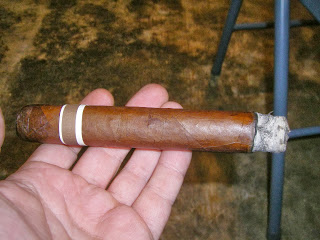 |
| RoMa Craft Tobac Aquitaine Blockhead |
The Aquitaine Blockhead is a limited production cigar that recently has been released by RoMa Craft Tobac. The cigar had previously only been available as an event only cigar, but an allocation has recently been made available to Monte’s Pueblo Pipe Shop in Albuquerque, New Mexico. The Blockhead introduces a box-pressed Gran Toro into the Aquitaine line. Earlier this year, the Aquitaine’s sibling line, CroMagnon had an equivalent shaped Blockhead vitola released to Tower Pipes & Cigars (Sacramento, CA) and Tobacco Grove (Maple Grove, MN). Recently, I had an opportunity to smoke the Aquitaine Blockhead. Overall, I found this to be an excellent cigar. In particular, I found that the box-press shape to do some nice things for the Aquitaine blend.
The Aquitaine is a variant from RoMaCraft Tobac’s popular original CroMagnon line. The main difference is the Aquitaine uses Ecuadorian Habano wrapper on a similar binder and filler to the original CroMagnon. The Aquitaine was launched at the 2013 IPCPR Trade Show.
Without further ado, let’s take a closer look at the Aquitaine in the Blockhead vitola and see what this cigar brings to the table. As a disclaimer, this cigar was based on a single cigar smoking experience.
Binder: Cameroon
Filler: Nicaraguan (3 Fillers): Esteli, Condega, and a ligero leaf from Pueblo Nuevo (a small farm north of Esteli on the Honduran border)
“…the Aquitaine features a beautiful Ecuador Habano Ligero wrapper selected from the best tobacco we could find. This eighth and ninth priming ligero leaf is thick, oily and has amazing texture. The filler leaf for this blend was acquired from three separate growing regions in Nicaragua: Esteli, Condega and a small farm north of Esteli on the Honduran border, Pueblo Nuevo. This third leaf, a ligero, brings a strong, smoky, savory flavor to the blend.“
Mandible (Petit Gordo): 4 ½ x 60
EMH (Early Modern Human) (Robusto Extra): 5 x 56 –
Anthropology (Grand Corona): 5 ¾ x 46
Cranium (Gran Toro): 6 x 54
Atlatl (Lancero – Limited Edition): 7 x 38
The Blockhead features the Aquitaine’s new banding. Three is a thin brown band with the text “Aquitaine” embossed on it. The back of the band contains the RoMa Craft Tobac logo. The brown band sits on top of a thicker white band.
Preparation for the Cigar Experience
Prior to lighting up the Aquitaine Blockhead, I went with a straight cut to remove the cap. From that point, I moved on to the pre-light draw. The dry draw contained a mix of natural tobacco sweetness and background cedar notes. The Blockhead seemed to deliver a different pre-light draw than I remembered on the other vitolas, but it was still a satisfying one. At this point, I was ready to light up the Aquitaine Blockhead and see what the overall smoking experience would bring to the table.
Flavor Profile
I found the Aquitaine Blockhead to have a complex flavor profile with a lot of flavor nuances. It had been a while since I did a formal assessment of an Aquitaine, but to me this blend has really matured over time.
The start to the Aquitaine Blockhead provided a mix of natural tobacco, wood, and pepper. There were also some floral notes that were present in the forefront. By about the five percent mark, the wood notes turned nutty – still remaining in the forefront. The floral notes joined the nut and natural tobacco in the forefront. Around the same time, the pepper notes receded into the background. Meanwhile, I detected a nice exotic spice on the retro-hale.
Toward the middle the first third, the Aquitaine was throwing a lot of sweetness. There was a definite natural tobacco feel to the sweetness. The floral notes had changed to a mild cherry flavor – complementing the natural tobacco. Meanwhile in the background the pepper morphed into more of a baker’s spice.
In the second third the natural tobacco sweetness still was the primary note. The nut flavors receded into the background with the spice. I also picked up some cocoa and earth notes. As the Aquitaine Blockhead burned through the second third, the cocoa and earth notes increased. The spice seemed to move away from the baker’s spice and back to more of a pepper note.
By the latter part of the second third, the cocoa/earth combination took over. The natural tobacco, spice, and nut notes were secondary. In the last third, the Aquitaine Blockhead became more of a combination of earth and spice. While there was some spice at the end, I did not find the Aquitaine Blockhead to be harsh. The resulting nub was cool in temperature, but slightly soft to the touch.
Burn and Draw
Overall I found the Aquitaine Blockhead to be a cigar of excellent construction and this was reflected in the burn and draw attributes. The burn line remained straight providing a sharp burn for most of the cigar experience. At the same time the Blockhead required minimal touch-ups to keep the burn on track. The resulting ash was tight and firm with a nice salt and pepper colored ash. The burn rate and burn temperature were both ideal.
 |
| Burn of the Aquitaine Blockhead |
The draw performed very well for the Aquitaine Blockhead. It was not too tight and not too loose – making for an enjoyable cigar experience from start to finish.
Strength and Body
From a strength perspective, I did find that the Aquitaine Blockhead had some kick from a nicotine perspective. I assessed this cigar as being medium to full in strength. As for the flavors, they had some nice depth and were definitely robust. The Blockhead qualified for a full-bodied cigar in my book. While there is no doubt the ligero gives this cigar a nice kick in strength, I was still pleasantly surprised how the flavors shined here. With the Aquitaine Blockhead, I gave a slight edge to body over strength.
Final Thoughts
It had been a while since I revisited the Aquitaine blend. Recently, I have been smoking several other vitolas int he line Overall, I was quite pleased with the way the Aquitaine blend was smoking as a whole. To me, the box-press vitola for this blend seemed to click on all cylinders. By far, this has become my favorite offering in the Aquitaine. Perhaps the best quality was the complexity I derived from this cigar’s flavor profile. The Aquitaine Blockhead is a stronger, fuller cigar. It is something that I would recommend to a more seasoned cigar enthusiast who can handle such a cigar. As for myself, this is a cigar I really enjoyed. It is one I would smoke again – and one worthy of a box split.
Summary
Burn: Excellent
Assessment: 3.5 – Box Split
Score: 92
References
Price: $9.00
Source: Sample provided by RoMa Craft Tobac
Stogie Geeks Podcast: Episode 52 – “Broadleaf Baby!” (Aquitaine Anthropology)
Stogie Feed: Aquitaine Anthropology by Roma Craft
* The cigar for this assessment was given to Cigar Coop by RoMa Craft Tobac. Cigar Coop is appreciative for the sample, but this does not influence the review.




